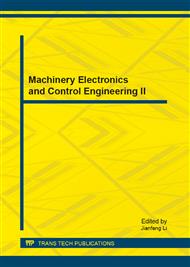p.287
p.291
p.296
p.300
p.304
p.308
p.312
p.316
p.320
The Detection System of Adaptive Electrochemical Micro Electric Current
Abstract:
The existing micro current detecting apparatus is of large size and is manual controlled. When the detected currents sensitivity is higher, however, stability will be worse. In order to solve this problem, an adaptive detection system is proposed in this paper. The system designed a micro current signal detection circuit based on OK6410 embedded with development board. The Weak current signal is collected with the high precision ADC. Automatic adjustment circuit gain is from 1 to 10000. Spectrometer wavelength size is changed in real-time. Current resolution can reach nA. The experimental results show that this system can collect the micro current effectively. The main characteristics of the system are simple circuit structure, small volume, high degree of automation, and strong reliability, and it greatly improves the anti-interference performance of the circuit. The system can not only be applied in electrochemical current detection, but also be widely used in weak signal detection.
Info:
Periodical:
Pages:
304-307
Citation:
Online since:
March 2013
Authors:
Price:
Сopyright:
© 2013 Trans Tech Publications Ltd. All Rights Reserved
Share:
Citation:


